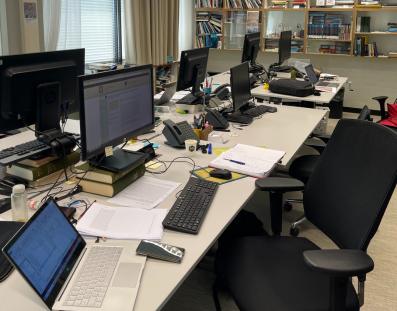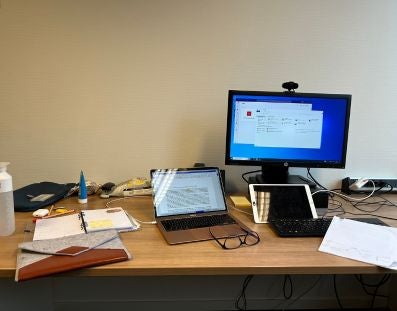Hybrid working highlights the popularity of screens and how they expand our universe through our hands and eyes. Touch remains important, although repetitive. Vision is central and is intensively stimulated: eyes flutter between devices, tabs, windows. Increasingly we listen to colleagues over headphones and speakers. The set of pictures in this section invites you to consider: how do screens participate in the situations you are part of? Do they draw you into situations or distract you from them? Is there a workplace beyond or without screens? Let’s navigate through the ‘waves’ of the sea of screens.
Between papers and screens
This first picture was taken by one of the project researchers and has an interesting story behind it. The interviewer and interviewee, let’s call them Betty and Maria, were walking through the corridors of one of the university’s departments. The interview had just finished, and Betty kindly offered Maria a tour around the facilities. As they advanced, they found colleagues on the way, and Betty was friendly in introducing Maria to everyone, giving her the floor to explain the research further and take pictures. The room was busy. People working side-by-side were disrupted and kindly asked to leave their stations so that Maria could take a photograph. Bodies moved, but objects remained. Objects were present as participants of the scene while the humans were protectively removed from it.
Mobile screens are essentially the heart of hybrid working. They bounce from one corner to another and guide our eyes into a route distinct from the one where our body is. They define our path, our views, and our actions. Yet, we rarely see them.
What caught your attention first? Do you also use several screens to do your work? Do they complete or compete with each other?
Credits: Shared screens © 2023 by Hybrid Working Project VU Amsterdam is licensed under CC BY-NC-ND 4.0. To view a copy of this license, visit http://creativecommons.org/licenses/by-nc-nd/4.0/
Note that we intentionally don’t show people in this image.

